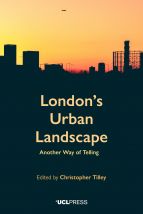London’s Urban Landscape: Another Way of Telling

This book emerged from a small academic community: students or teachers of material culture at University College London (UCL). Each contributor covers a specific residential or public location in London, paying attention to the interactions between people and places. As editor Christopher Tilley puts it, “this book aims to at least partially, and in an exploratory way, fill these two gaps in the literature: a) the paucity of thick ethnographic descriptions of places in London, and b) discussion of the material significance of the places forming London’s urban landscape in relation to everyday life” (page xxii).
Close to UCL is the Brunswick Centre, a housing and shopping centre built in a postwar modernist style. Clare Melhuish’s chapter charts the various phases of the centre, from idealistic intentions to perceived seediness, through to refurbishment and bureaucratic veneration as a listed structure. Melhuish also interviews residents of the complex, who describe how their sense of connection to central London depends on their outdoor views through the structure’s distinctive atrium-style windows. They also detail the changes in their relationship with the centre as they find ways to forge community within (or despite) the imposing architecture. Clearly the Brunswick Centre has carried many meanings in its decades of existence, and its design continues to be alternately praised and condemned by the people who engage with it daily.
The chapter describing narrowboats along London canals, by boater anthropologist Titika Malkogeorgou, is more meditative. It combines richly detailed imagery (Malkogeorgou memorably describes new buildings as “a faux constructivist slash modern eclectic international blah” [page 207]) with a brief history of London’s canal system (which no longer have industrial uses). The texture of life on the canals is presented via trade-offs between mobility and logistics, between freedom and isolation, between privacy and containment. Canal life is also analysed as a particular version of the city – a “linear village” in which “central London” is actually located further east than land-dwellers might consider.
These chapters and others use a combination of photographs, visual descriptions, and more scholarly analysis (the word “phenomenology” comes up often). Each chapter ends with a methodological note that explains the author’s engagement with the studied location. Through this mixture of methods and tones, London’s Urban Landscape encourages different ways of seeing inside and through the city’s structures.
Book available open access from:
https://www.uclpress.co.uk/products/124525
Search the Book notes database
Our Book notes database contains details and summaries of all the publications included in Book notes since 1993 - with details on how to obtain/download.
Use the search form above, or visit the Book notes landing page for more options and latest content.
For a searchable database for papers in Environment and Urbanization, go to http://eau.sagepub.com/

